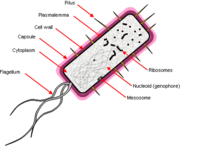Difference between revisions of "Bacteria"
(added citation to answers in genesis) |
(Resistance of bacteria is not evidence for the ToE) |
||
| Line 2: | Line 2: | ||
'''Bacteria''' are single-celled microorganisms. Modern [[pathology]] and [[medicine]] are based on the findings of [[Louis Pasteur]] and later [[Robert Koch]] and [[Charles Laveran]] that bacteria cause many ailments, but most microbes, in agreement with the benevolent nature of the [[Creator]], are actually beneficial to man and nature.<ref name="AiG Bacteria">[http://www.answersingenesis.org/articles/arj/v1/n1/microbes-days-of-creation Microbes and the Days of Creation], Answers: Research Journal.</ref> Bible scholars have dated their creation between Day 3 and 6 during Creation Week.<ref name="AiG Bacteria">[http://www.answersingenesis.org/articles/arj/v1/n1/microbes-days-of-creation Microbes and the Days of Creation], Answers: Research Journal.</ref> | '''Bacteria''' are single-celled microorganisms. Modern [[pathology]] and [[medicine]] are based on the findings of [[Louis Pasteur]] and later [[Robert Koch]] and [[Charles Laveran]] that bacteria cause many ailments, but most microbes, in agreement with the benevolent nature of the [[Creator]], are actually beneficial to man and nature.<ref name="AiG Bacteria">[http://www.answersingenesis.org/articles/arj/v1/n1/microbes-days-of-creation Microbes and the Days of Creation], Answers: Research Journal.</ref> Bible scholars have dated their creation between Day 3 and 6 during Creation Week.<ref name="AiG Bacteria">[http://www.answersingenesis.org/articles/arj/v1/n1/microbes-days-of-creation Microbes and the Days of Creation], Answers: Research Journal.</ref> | ||
| − | Bacterial [[disease]] was a source of fear for humankind for most of [[history]]. This fear was largely abated by the development of [[antibiotic]] drugs in the last half of the 1900s. The general impression was that most bacterial diseases could be cured, relatively quickly and easily. But bacteria gain resistance to certain types of antibiotics, making their continued treatment in a recurrent infection difficult at times.<ref>[http://www.chemheritage.org/educationalservices/pharm/antibiot/readings/evolve.htm antibiot-readings]</ref> However, this is not [[evolution]], since the bacteria do not change from one type to another | + | Bacterial [[disease]] was a source of fear for humankind for most of [[history]]. This fear was largely abated by the development of [[antibiotic]] drugs in the last half of the 1900s. The general impression was that most bacterial diseases could be cured, relatively quickly and easily. But bacteria gain resistance to certain types of antibiotics, making their continued treatment in a recurrent infection difficult at times.<ref>[http://www.chemheritage.org/educationalservices/pharm/antibiot/readings/evolve.htm antibiot-readings]</ref> However, this is not evidence for the [[theory of evolution]], since the bacteria do not change from one type to another. They only gain or lose a few genes involved in the antibiotic, and no new information is created, in this process known as [[microevolution]] or adaptation. Bacterial disease is becoming a more serious medical problem, particularly in hospitals which tend to harbor a population of drug-resistant bacteria. |
Bacteria are tiny one-celled organisms present throughout the environment that require a microscope to be seen. The vast majority of bacteria are not harmful to human beings. Many of them are normally found on or in the human body, and not only do not cause disease, but provide some benefit. For example, the human gut normally contain a complement of ''intestinal flora'' which assist digestion. | Bacteria are tiny one-celled organisms present throughout the environment that require a microscope to be seen. The vast majority of bacteria are not harmful to human beings. Many of them are normally found on or in the human body, and not only do not cause disease, but provide some benefit. For example, the human gut normally contain a complement of ''intestinal flora'' which assist digestion. | ||
Revision as of 20:02, April 26, 2011
Bacteria are single-celled microorganisms. Modern pathology and medicine are based on the findings of Louis Pasteur and later Robert Koch and Charles Laveran that bacteria cause many ailments, but most microbes, in agreement with the benevolent nature of the Creator, are actually beneficial to man and nature.[1] Bible scholars have dated their creation between Day 3 and 6 during Creation Week.[1]
Bacterial disease was a source of fear for humankind for most of history. This fear was largely abated by the development of antibiotic drugs in the last half of the 1900s. The general impression was that most bacterial diseases could be cured, relatively quickly and easily. But bacteria gain resistance to certain types of antibiotics, making their continued treatment in a recurrent infection difficult at times.[2] However, this is not evidence for the theory of evolution, since the bacteria do not change from one type to another. They only gain or lose a few genes involved in the antibiotic, and no new information is created, in this process known as microevolution or adaptation. Bacterial disease is becoming a more serious medical problem, particularly in hospitals which tend to harbor a population of drug-resistant bacteria.
Bacteria are tiny one-celled organisms present throughout the environment that require a microscope to be seen. The vast majority of bacteria are not harmful to human beings. Many of them are normally found on or in the human body, and not only do not cause disease, but provide some benefit. For example, the human gut normally contain a complement of intestinal flora which assist digestion.
Some food products involve bacteria in their production. Sour cream, buttermilk, yogurt, and some kinds of cheese contain living cultures of live bacteria when eaten. Vinegar is traditionally produced by the growth of the Acetobacter bacterium in wine. (Wine itself is produced, not by bacteria, but by yeast, which is also a microorganism that is classified as a fungi.)
While not all bacteria are harmful, some cause disease. The technical term for these is pathogenic bacteria (pathogenic being nothing more than a combination of the Greek roots for "disease" and "causing").
Examples of bacterial disease include diphtheria, pertussis, tetanus, Haemophilus influenza and pneumococcus (pneumonia).
See also
References
- ↑ 1.0 1.1 Microbes and the Days of Creation, Answers: Research Journal.
- ↑ antibiot-readings
